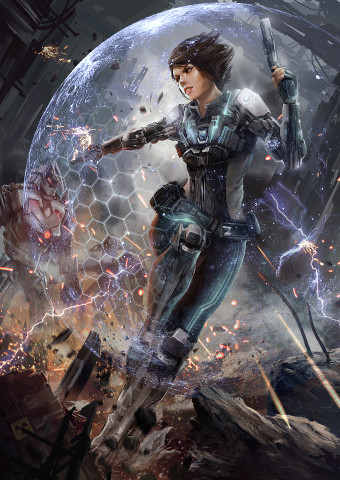Video Game Shields in GURPS

As we saw in a recent post, force screens in GURPS work in a manner that is almost, but not entirely unlike that of energy shields in popular game franchises like Borderlands, Mass Effect, or Warframe. If you’re familiar with these games and read GURPS for the first time, the differences might trip you up a bit.
Energy shields in these games usually work like a separate pool of HP. Attacks that hit your character take directly from this pool, which lets nothing through until it’s completely depleted. Once that happens the character must avoid getting hit for a few seconds before their shields start to regenerate, which in turn takes a few more seconds. Games that give players a lot of insight into their numbers tend to also provide lots of options to tweak your shield recharge delay and recharge rate. Still, recovering your shields is always easier than recovering your “real” HP, which requires healing items or powers.
These games also feature multiple damage types of varying effectiveness against each type of defense. An attack that’s good at damaging shields will usually be worse at damaging HP (and/or armor, if that’s a thing in the game), and vice-versa.
How would this look like in GURPS? Let’s make an attempt to adapt these mechanics.
Campaign Option: Energy Shields
This is a campaign option for settings which use force screens, making them work in a more “video-game-like” fashion (described above). It’s good for campaigns meant to emulate the games I discuss at the beginning of this post. If you’re instead trying to model something like Star Trek shields, use the default rules from Ultra-Tech instead.
Under these rules, Force Screens still provide the listed DR for the equipment in question, but this DR is considered fully Ablative and ignores all armor divisors. If an attack lowers the screen’s DR to 0, any excess damage is lost. Attacks with the Surge modifier cause double damage to force screens, and they protect from radiation as if it was damage. This does mean that an attack that does “rad sur” damage would do triple damage to a force screen.
Shields recover at the usual rate of 10% per second, but they only start recovering after the user spends 2 seconds without being hit by further attacks. If the user is hit while the shield is mid-recovery, it takes another 2 seconds before it can start again.
Shield Overflow: GMs who don’t want to bother with the bookkeeping can eliminate both the 2-second recharge delay and the “no overflow” property of force screens. This means that damage in excess of the shield’s DR applies to the user, but the screen begins recovering on the very next turn.
All force screen variants from Ultra-Tech p. 191-192 except Kinetic and Energy can still apply to force screens using this rule1.
Examples
Remember Tom Tomorrow and the Robber Baron? Let’s see how their many confrontations would have happened under this rule. As before, Tom Tomorrow has a DR 60 personal force screen and a DR 30/15* armored space suit, and the Baron has an increasingly absurd modern arsenal.
During the First National Bank robbery, each shot from the Baron’s 9mm pistol (damage 2d+2 pi) would reduce the DR of Tom’s Force Screen by 9 on average. It would take 7 shots to disable the force screen entirely, but until that happens Tom is completely safe from the Baron’s gunfire. Tom can’t just stand there and laugh at the villain anymore, but he can still easily make the arrest.
During the Second National Bank robbery, each shot from the baron’s assault rifle (damage 5d pi) would reduce the DR of Tom’s Force Screen by 18! It will only take four of them before Tom’s shields are down, forcing him to be a lot more careful this time around. He can still take a lucky burst and survive unscathed, but likely has to hide behind some hard cover once or twice to let his shields recover. He’s still quite a bit safer than a mundane cop would be, though.
During the Third National Bank Robbery, the Baron’s antitank grenade (damage 4d(10) cr exp) would reduce the screen’s DR by 14, but Tom himself would be completely unaffected by the explosion! The Baron would likely be so surprised by this Tom would easily be able to handcuff him for the third and final time.
If the Baron somehow got ahold of a death ray (6d burn rad sur), each shot from that weapon would do 63 damage to Tom’s shields on average, meaning a single shot would be enough to destroy them! Tom himself would still be unaffected, but subsequent shots would threathen him directly until he had a couple of seconds to let his screen recharge at least a little. Luckily for him and for Paragon City, futuristic beam weapons are totally outside the Baron’s idiom.
-
Well, you can allow them if you really want to, but that will lead to a setting like Gun Gale Online, where everyone only uses weapons that ignore shields. ↩